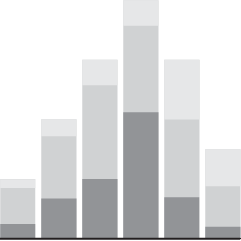Where the Time Goes with Age
We get 24 hours in a day. How do we spend this time? How does our time use change as we get older and priorities shift?
Here is the percentage breakdown in our teens, 20s, and 30s, through to our 80s.
How Americans spend their days, by age group

As you might expect, education takes more time in the younger years. Work and household responsibilities expand in the middle. Relaxation takes over in the later years.
This is based on data from the 2021 and 2022 American Time Use Surveys. I counted the total minutes spent on each activity and age group. Then I divided by the total minutes spent in each age group. So the percentages are averages.
The above are general activity categories, but ATUS provides more detailed classifications, which provide a better view of the everyday.
Most of the time
We use about 40% of our time for personal care, which includes sleep and grooming. The second biggest chunk of time goes to socializing, relaxing, and leisure.

Time for socializing, relaxing, and leisure more than doubles from our 30s. Although a lot of that seems to go towards watching television and not so much the socializing. This seems right, but I’m not sure I look forward to that.
A lot of the time
Work and work-related activities peak in our 40s.
Education is part going to class and part homework and uses a chunk of time, but it’s lower than I expected. School just seemed like all the time when I was young. Maybe not?
Household activities pick up later.

Not everyone works and not everyone goes to school, so a breakdown by work status could be useful here.
Some of the time
In between the main activities in our everyday, we use the minutes in between to do everything else. Commute, caring for others if we have kids (or an older parent), shopping, and telephone calls.
The peak for exercise in the teen years jumps out. My waistline seems to confirm.

Rest of the time
Then there are the less everyday things.

Notes
The data comes from the 2021-2022 American Time Use Survey, which I downloaded via IPUMS. I processed the data in Python. I analyzed and visualized the data in R. I edited in Illustrator.
Become a member. Support an independent site. Make great charts.
See What You GetFlowingData is made possible by supporting members. Since 2007, I, Nathan Yau, a real person, have been analyzing and visualizing data to help more people understand and appreciate it in their everyday lives.
If you liked this or want to make similar data things, please consider supporting this small corner of the internet. You get unlimited access to visualization courses, tutorials, and extra resources. Thanks. — Nathan


